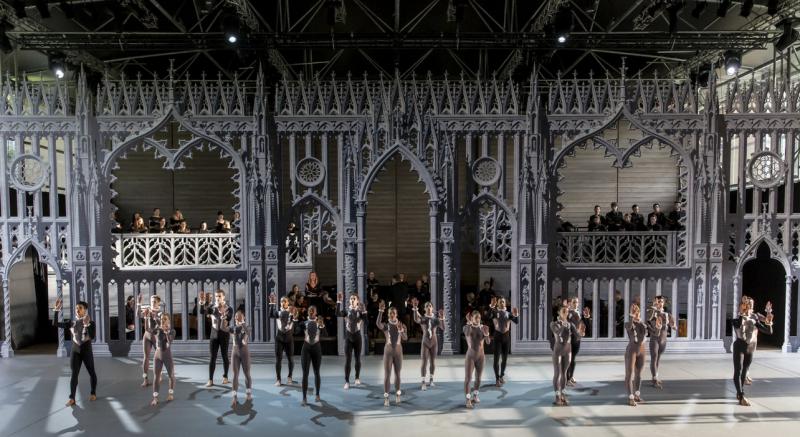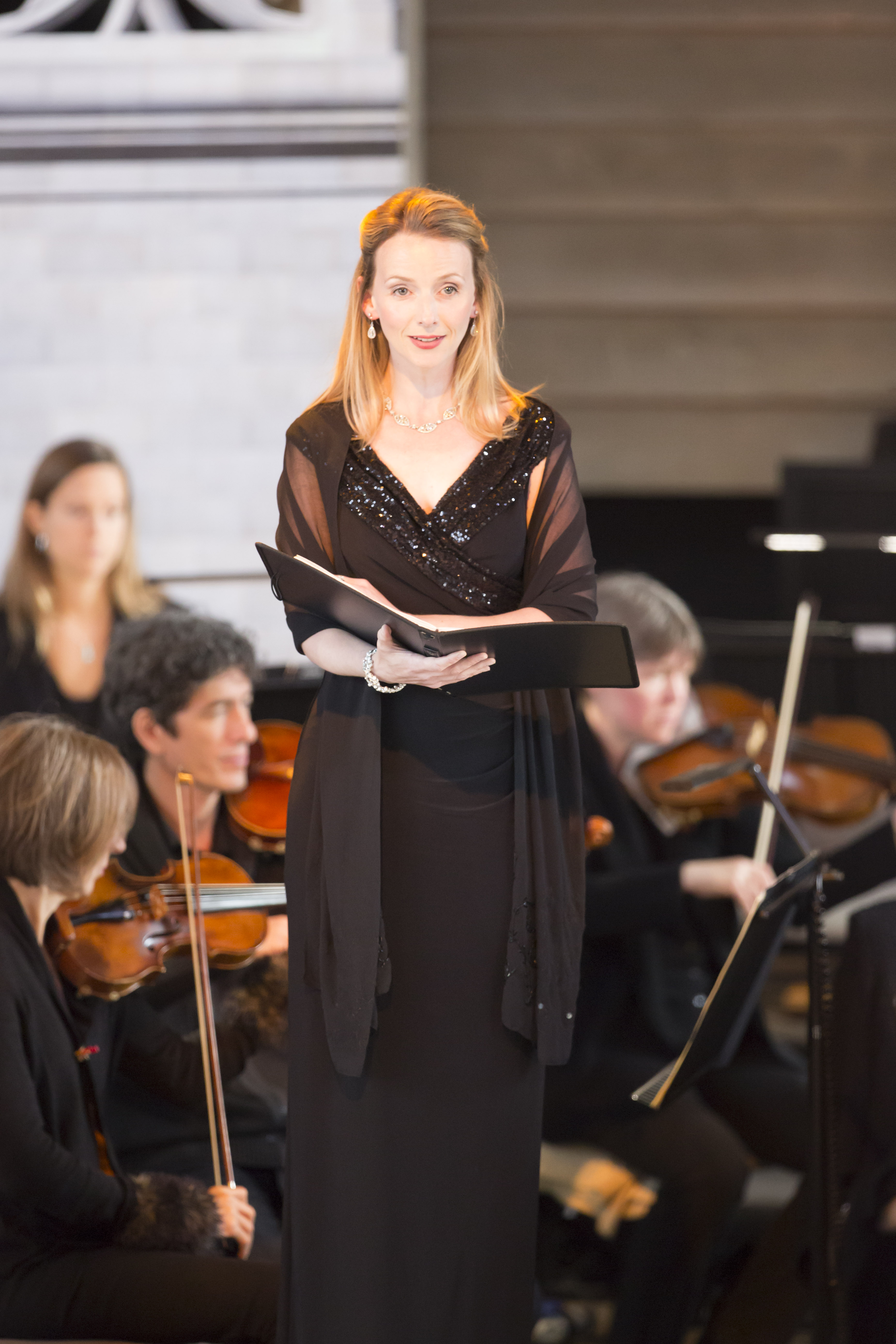The Creation, Garsington Opera | reviews, news & interviews
The Creation, Garsington Opera
The Creation, Garsington Opera
Dance-staging of Haydn's oratorio moves from chaos to creation and back again

Once confined to the concert hall, it’s a rare oratorio these days that doesn’t duck under the fence and sneak into the opera house. Bach’s Passions and most of Handel’s religious works have already made the transition, but this season it’s the turn of Haydn’s Creation. Rejecting the classic staged route, Garsington Opera have invited Mark Baldwin to choreograph it for his Rambert dancers.
But any opera-goers expecting an oratorio with movement should be warned at the outset: this is a dance piece with music. The hierarchy is clear from every detail of a show that should (and so easily could) have been a meeting of two genres, but which unfolds instead as a physical monologue that just occasionally acknowledges the presence of an aural element.
 Bronstein’s set is strikingly simple. An intricately carved Gothic rood screen (beautifully lit by Mark Henderson) fills the breadth of the stage, separating foreground dancers from the mysteries of the orchestra and chorus, which take place behind. We glimpse the latter through archways and above columns, but their presence remains a distant one. Dressed in concert black, soloists Sarah Tynan, James Gilchrist and Neal Davies step into view for their music, but remain clearly articulated as part of an uncostumed, uncharacterised backing group – an accompaniment to the drama, not a part of it.
Bronstein’s set is strikingly simple. An intricately carved Gothic rood screen (beautifully lit by Mark Henderson) fills the breadth of the stage, separating foreground dancers from the mysteries of the orchestra and chorus, which take place behind. We glimpse the latter through archways and above columns, but their presence remains a distant one. Dressed in concert black, soloists Sarah Tynan, James Gilchrist and Neal Davies step into view for their music, but remain clearly articulated as part of an uncostumed, uncharacterised backing group – an accompaniment to the drama, not a part of it.
Echoing the architecture of the screen, Baldwin’s dancers (pictured above right) are all ruffs and lycra breastplates, though why remains unclear. There’s little of penitential late-Medieval Christianity in Haydn’s joyous, optimistic oratorio, and no amount of stern choreography can make it so. In an attempt to avoid a too literal response to Haydn’s music, Baldwin ignores almost all musical cues. Not just thematic or narrative ones (tigers, eagles and stars are all created without visual echo, though the worm does get a brief comic nod from one dancer), but even those of rhythm and structural unit.
With the exception of an inexplicable gap in Part III, dance is continuous and wilfully at odds with the music. The creeping consciousness of Haydn’s move from chaos to light is treated as the soundtrack to a vigorous set of calisthenic movements that arrive fully-formed – no evolution here. Dances unfold in sequences of duets, trios and larger ensembles, often shifting mood and personnel four or five times within a single aria. The clear musical architecture of recitative/aria is deliberately fragmented, and the result is that while singers take us from delicate pianissimo to full chorus shout, the visuals remain at a constant mezzo-forte. Occasional nods to the sung text feel token among so much abstraction, and a brief cheek peck between Adam and Eve manifests as kitsch rather than touching.
 It’s a shame, because taken on its own terms the movement is a glorious narrative of curving shapes and collective statements – classic Rambert. The young dancers of the Rambert School are particularly impressive, massed forces who can whisper as well as shout their gestures.
It’s a shame, because taken on its own terms the movement is a glorious narrative of curving shapes and collective statements – classic Rambert. The young dancers of the Rambert School are particularly impressive, massed forces who can whisper as well as shout their gestures.
The music too is sensational. What a pleasure to hear Haydn’s rich score sung with such clarity and colour by the Garsington Chorus, echoing and supporting the tender interactions of Sarah Tynan’s Eve/Gabriel (pictured left) and Neal Davies’s Raphael/Adam. No one tells a musical story with more wonder, more delicacy than James Gilchrist, who delivered the English text with an Evangelist’s care. Under Douglas Boyd’s direction ensemble occasionally rocked (perhaps awkward sightlines are to blame), but the music found a brisk pace the bright colours that the visuals so stubbornly denied.
Haydn’s oratorio is one of the great music-dramas, a story whose generous lens takes in the creation of the whole world while also finding time for the small details – individual birds, flowers, insects. If there’s something that dance can add here, then Baldwin didn’t find it on this occasion.
- The Creation is at Garsington Opera untl 17 July
rating
Explore topics
Share this article
The future of Arts Journalism
You can stop theartsdesk.com closing!
We urgently need financing to survive. Our fundraising drive has thus far raised £49,000 but we need to reach £100,000 or we will be forced to close. Please contribute here: https://gofund.me/c3f6033d
And if you can forward this information to anyone who might assist, we’d be grateful.

Subscribe to theartsdesk.com
Thank you for continuing to read our work on theartsdesk.com. For unlimited access to every article in its entirety, including our archive of more than 15,000 pieces, we're asking for £5 per month or £40 per year. We feel it's a very good deal, and hope you do too.
To take a subscription now simply click here.
And if you're looking for that extra gift for a friend or family member, why not treat them to a theartsdesk.com gift subscription?
more Classical music
 Scottish Chamber Orchestra, Ibragimova, Queen’s Hall, Edinburgh review - rarities, novelties and drumrolls
A pity the SCO didn't pick a better showcase for a shining guest artist
Scottish Chamber Orchestra, Ibragimova, Queen’s Hall, Edinburgh review - rarities, novelties and drumrolls
A pity the SCO didn't pick a better showcase for a shining guest artist
 Kilsby, Parkes, Sinfonia of London, Wilson, Barbican review - string things zing and sing in expert hands
British masterpieces for strings plus other-worldly tenor and horn - and a muscular rarity
Kilsby, Parkes, Sinfonia of London, Wilson, Barbican review - string things zing and sing in expert hands
British masterpieces for strings plus other-worldly tenor and horn - and a muscular rarity
 From Historical to Hip-Hop, Classically Black Music Festival, Kings Place review - a cluster of impressive stars for the future
From quasi-Mozartian elegance to the gritty humour of a kitchen inspection
From Historical to Hip-Hop, Classically Black Music Festival, Kings Place review - a cluster of impressive stars for the future
From quasi-Mozartian elegance to the gritty humour of a kitchen inspection
 Shibe, LSO, Adès, Barbican review - gaudy and glorious new music alongside serene Sibelius
Adès’s passion makes persuasive case for the music he loves, both new and old
Shibe, LSO, Adès, Barbican review - gaudy and glorious new music alongside serene Sibelius
Adès’s passion makes persuasive case for the music he loves, both new and old
 Anja Mittermüller, Richard Fu, Wigmore Hall review - a glorious hall debut
The Austrian mezzo shines - at the age of 22
Anja Mittermüller, Richard Fu, Wigmore Hall review - a glorious hall debut
The Austrian mezzo shines - at the age of 22
 First Person: clarinettist Oliver Pashley on the new horizons of The Hermes Experiment's latest album
Compositions by members of this unusual quartet feature for the first time
First Person: clarinettist Oliver Pashley on the new horizons of The Hermes Experiment's latest album
Compositions by members of this unusual quartet feature for the first time
 Gesualdo Passione, Les Arts Florissants, Amala Dior Company, Barbican review - inspired collaboration excavates the music's humanity
At times it was like watching an anarchic religious procession
Gesualdo Passione, Les Arts Florissants, Amala Dior Company, Barbican review - inspired collaboration excavates the music's humanity
At times it was like watching an anarchic religious procession
 Classical CDs: Camels, concrete and cabaret
An influential American composer's 90th birthday box, plus British piano concertos and a father-and-son duo
Classical CDs: Camels, concrete and cabaret
An influential American composer's 90th birthday box, plus British piano concertos and a father-and-son duo
 Cockerham, Manchester Camerata, Sheen, Martin Harris Centre, Manchester review - re-enacting the dawn of modernism
Two UK premieres added to three miniatures from a seminal event of January 1914
Cockerham, Manchester Camerata, Sheen, Martin Harris Centre, Manchester review - re-enacting the dawn of modernism
Two UK premieres added to three miniatures from a seminal event of January 1914
 Kempf, Brno Philharmonic, Davies, Bridgewater Hall, Manchester review - European tradition meets American jazz
Bouncing Czechs enjoy their Gershwin and Brubeck alongside Janáček and Dvořák
Kempf, Brno Philharmonic, Davies, Bridgewater Hall, Manchester review - European tradition meets American jazz
Bouncing Czechs enjoy their Gershwin and Brubeck alongside Janáček and Dvořák
 Solomon, OAE, Butt, QEH review - daft Biblical whitewashing with great choruses
Even a top soprano and mezzo can’t make this Handel paean wholly convincing
Solomon, OAE, Butt, QEH review - daft Biblical whitewashing with great choruses
Even a top soprano and mezzo can’t make this Handel paean wholly convincing
 Two-Piano Gala, Kings Place review - shining constellations
London Piano Festival curators and illustrious friends entertain and enlighten
Two-Piano Gala, Kings Place review - shining constellations
London Piano Festival curators and illustrious friends entertain and enlighten

Add comment